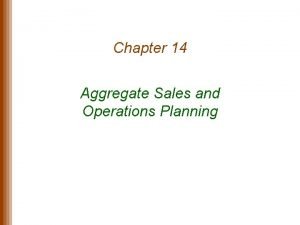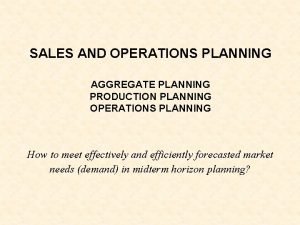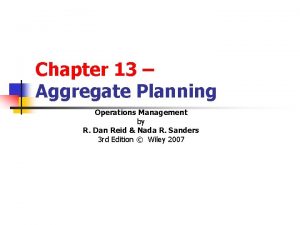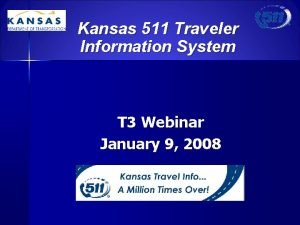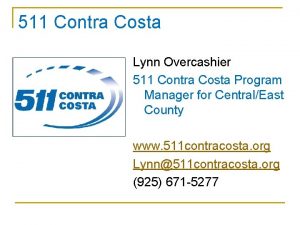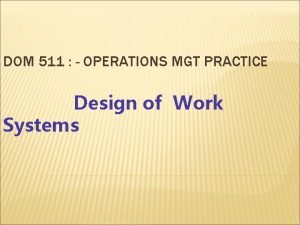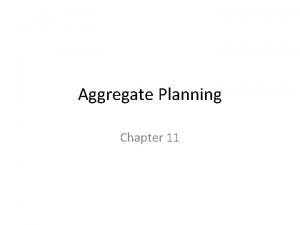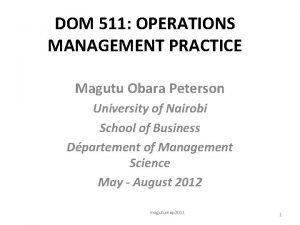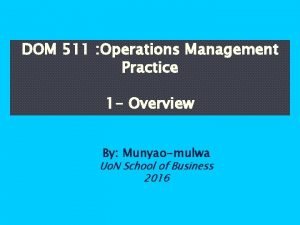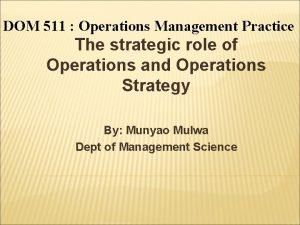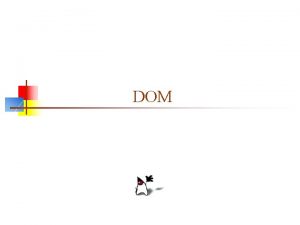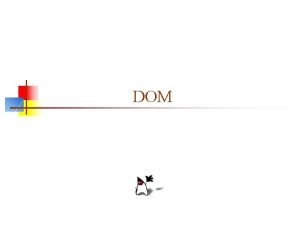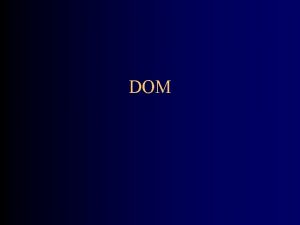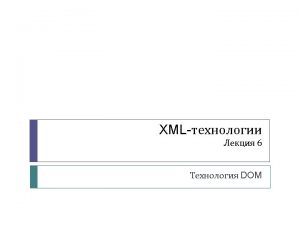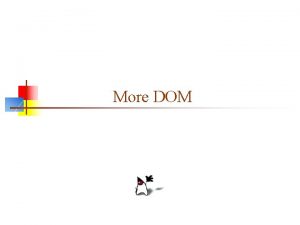1 DOM 511 Operations Mgt Practice Aggregate Planning
















- Slides: 16

1 DOM 511: Operations Mgt Practice Aggregate Planning ©The Mc. Graw-Hill Companies, Inc. , 2004

2 OBJECTIVES • Sales and Operations Planning • The Aggregate Operations Plan • Examples: Chase and Level strategies ©The Mc. Graw-Hill Companies, Inc. , 2004

3 Process planning Long range Strategic capacity planning Intermediate Forecasting & demand range management Manufacturing Sales and operations (aggregate) planning Sales plan Aggregate operations plan Services Master scheduling Material requirements planning Short range Order scheduling Weekly workforce and customer scheduling Daily workforce and customer scheduling ©The Mc. Graw-Hill Companies, Inc. , 2004

4 Sales and Operations Planning Activities • Long-range planning – – Greater than one year planning horizon Usually performed in annual increments • Medium-range planning – – Six to eighteen months Usually with monthly or quarterly increments • Short-range planning – – One day to less than six months Usually with weekly increments ©The Mc. Graw-Hill Companies, Inc. , 2004

5 The Aggregate Operations Plan • Main purpose: Specify the optimal combination of – production rate (units completed per unit of time) – workforce level (number of workers) – inventory on hand (inventory carried from previous period) • Product group or broad category (Aggregation) • This planning is done over an intermediate-range planning period of 6 to 18 months ©The Mc. Graw-Hill Companies, Inc. , 2004

6 Balancing Aggregate Demand Aggregate Production Capacity Suppose the figure to the right represents forecast demand in units Now suppose this lower figure represents the aggregate capacity of the company to meet demand 10000 8000 6000 7000 6000 5500 4000 2000 0 Jan Feb Mar 9000 10000 Apr May Jun 8000 What we want to do is balance out the production rate, workforce levels, and inventory to make these figures match up 6000 4500 4000 Jan Feb 4000 2000 0 Mar Apr May Jun ©The Mc. Graw-Hill Companies, Inc. , 2004

Required Inputs to the Production Planning System Competitors’ behavior External capacity Current physical capacity Raw material availability Planning for production Current workforce Inventory levels Market demand External to firm Economic conditions Activities required for production Internal to firm ©The Mc. Graw-Hill Companies, Inc. , 2004 7

8 Key Strategies for Meeting Demand • Chase strategy • Stable Workforce strategy • Level strategy • Some combination of the two • Subcontracting ©The Mc. Graw-Hill Companies, Inc. , 2004

Aggregate Planning Examples: Unit Demand Cost Data Suppose we have the following unit demand cost information: Demand/mo Jan Feb Mar Apr May Jun 4500 5500 7000 10000 8000 6000 Materials Holding costs Marginal cost of stockout Hiring and training cost Layoff costs Labor hours required Straight time labor cost Beginning inventory Productive hours/worker/day Paid straight hrs/day $5/unit $1/unit per mo. $1. 25/unit per mo. $200/worker $250/worker. 15 hrs/unit $8/hour 250 units 7. 25 8 ©The Mc. Graw-Hill Companies, Inc. , 2004 9

10 Cut-and-Try Example: Determining Straight Labor Costs and Output Given the demand cost information below, what are the aggregate hours/worker/month, units/worker, and dollars/worker? Demand/mo Jun Jan Feb Mar 4500 5500 7000 Productive hours/worker/day 6000 Paid straight hrs/day 22 x 8 hrsx$8=$140 8 Apr May 7. 25 x 22 10000 7. 25 8000 8 7. 25 x 0. 15=48. 33 & 84. 33 x 22=1063. 33 ©The Mc. Graw-Hill Companies, Inc. , 2004

11 Chase Strategy (Hiring & Firing to meet demand) Lets assume our current workforce is 7 workers. First, calculate net requirements for production, or 4500 -250=4250 units Then, calculate number of workers needed to produce the net requirements, or 4250/1063. 33=3. 997 or 4 workers Finally, determine the number of workers to hire/fire. In this case we only need 4 workers, we have 7, so 3 can be fired. ©The Mc. Graw-Hill Companies, Inc. , 2004

12 Below are the complete calculations for the remaining months in the six month planning horizon ©The Mc. Graw-Hill Companies, Inc. , 2004

13 Below are the complete calculations for the remaining months in the six month planning horizon with the other costs included ©The Mc. Graw-Hill Companies, Inc. , 2004

14 Level Workforce Strategy (Surplus and Shortage Allowed) Lets take the same problem as before but this time use the Level Workforce strategy This time we will seek to use a workforce level of 6 workers ©The Mc. Graw-Hill Companies, Inc. , 2004

15 Below are the complete calculations for the remaining months in the six month planning horizon Note, if we recalculate this sheet with 7 workers we would have a surplus ©The Mc. Graw-Hill Companies, Inc. , 2004

16 Below are the complete calculations for the remaining months in the six month planning horizon with the other costs included Note, total costs under this strategy are less than Chase at $260. 408. 62 Labor Material Storage Stockout ©The Mc. Graw-Hill Companies, Inc. , 2004
 Aggregate planning excel solver
Aggregate planning excel solver Production plan example
Production plan example Aggregate planning objectives
Aggregate planning objectives Perencanaan agregat
Perencanaan agregat Aggregate capacity planning
Aggregate capacity planning Aggregate planning is capacity planning for
Aggregate planning is capacity planning for Chapter 33 aggregate demand and aggregate supply
Chapter 33 aggregate demand and aggregate supply How to calculate aggregate demand
How to calculate aggregate demand Tableau cannot mix aggregate and non aggregate
Tableau cannot mix aggregate and non aggregate Unit 3 aggregate demand and aggregate supply
Unit 3 aggregate demand and aggregate supply Tax multiplier formula
Tax multiplier formula Unit 3 aggregate demand aggregate supply and fiscal policy
Unit 3 aggregate demand aggregate supply and fiscal policy Royaume de clovis en 511
Royaume de clovis en 511 Kdot 511
Kdot 511 Eecs 511
Eecs 511 511 contra costa
511 contra costa Pet 511 kev
Pet 511 kev
